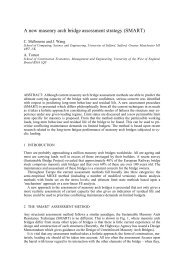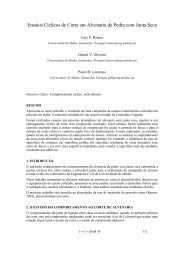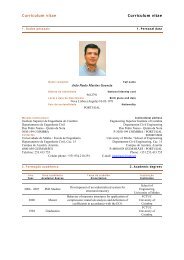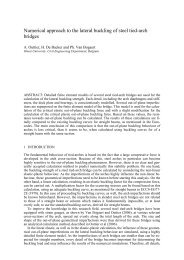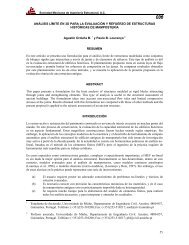Sustainable Construction A Life Cycle Approach in Engineering
Sustainable Construction A Life Cycle Approach in Engineering
Sustainable Construction A Life Cycle Approach in Engineering
You also want an ePaper? Increase the reach of your titles
YUMPU automatically turns print PDFs into web optimized ePapers that Google loves.
onmental changes. As architectural means, the build<strong>in</strong>gs‟ sk<strong>in</strong> must protect them from the environmental<br />
conditions and keep a mild and comfortable atmosphere <strong>in</strong>side for the human be<strong>in</strong>gs<br />
<strong>in</strong> order to make them feel themselves good. So it must be detailed carefully. In this concept<br />
of detail<strong>in</strong>g the sk<strong>in</strong> of the build<strong>in</strong>g, the energy com<strong>in</strong>g from the sun plays an important<br />
role. Its rays are wanted to enter the build<strong>in</strong>g <strong>in</strong> cold days while they are tried to be escaped<br />
from <strong>in</strong> hot days. The sk<strong>in</strong> of build<strong>in</strong>gs is generally composed of walls and roof . One of the design<br />
possibilities <strong>in</strong> this sense is the shad<strong>in</strong>g elements‟ design because walls conta<strong>in</strong> w<strong>in</strong>dows<br />
with<strong>in</strong> them. Due to the fact that w<strong>in</strong>dows let the sunsh<strong>in</strong>e get through them, they overheat the<br />
<strong>in</strong>terior.<br />
For the radiation control, solar radiation should be kept out <strong>in</strong> summer while it should be let<br />
<strong>in</strong> through the w<strong>in</strong>dows as much as possible <strong>in</strong> w<strong>in</strong>ter. “For any given locality the climatic conditions,<br />
ma<strong>in</strong>ly the temperature, give an <strong>in</strong>dex for outl<strong>in</strong><strong>in</strong>g cool and warm periods which can<br />
be designated as the “underheated” and “overheated” periods. The “overheated” period is the<br />
one when shad<strong>in</strong>g is needed.” (Olgyay & Olgyay, 1973, p.16) And the one when solar radiation<br />
is necessary <strong>in</strong> the <strong>in</strong>terior is the “underheated” period.<br />
As Olgyay & Olgyay stated (1973), “the effect of climatic elements on the human physiology<br />
can be graphically charted” (p.20). In Figure 1, the bioclimatic chart is given. The x-axis is the<br />
relative humidity while the y-axis is the temperature. Also shad<strong>in</strong>g, radiation, air movement,<br />
moisture are shown. At higher temperatures, w<strong>in</strong>d is required and the velocity of the required<br />
w<strong>in</strong>d is stated on the chart. If the humidity is high, required w<strong>in</strong>d velocity is also shown on the<br />
chart. In the comfort zone, people feel themselves comfortable. Below this zone there is the<br />
shad<strong>in</strong>g l<strong>in</strong>e (at around 21,1 ºC). Above this l<strong>in</strong>e, w<strong>in</strong>d and shad<strong>in</strong>g is required while below the<br />
l<strong>in</strong>e, solar radiation is necessary to feel comfortable. This shad<strong>in</strong>g l<strong>in</strong>e is important s<strong>in</strong>ce it determ<strong>in</strong>es<br />
the “Underheated zone” and the “Overheated zone”. Underheated zone is under the<br />
shad<strong>in</strong>g l<strong>in</strong>e and overheated zone is above it. Shad<strong>in</strong>g is necessary above the shad<strong>in</strong>g l<strong>in</strong>e at<br />
overheated zone.<br />
With the use of the meteorological data, the average values are found for the city <strong>in</strong> question.<br />
These average values are converted <strong>in</strong>to curves <strong>in</strong> a coord<strong>in</strong>ate system whose x-axis shows the<br />
days of the year and y-axis shows the hours of a day. When the graphics which show the average<br />
temperature curves and average relative humidity percentage curves are collided with keep<strong>in</strong>g<br />
the shad<strong>in</strong>g l<strong>in</strong>e <strong>in</strong> m<strong>in</strong>d, a shad<strong>in</strong>g l<strong>in</strong>e that is dependent on time is achieved. Therefore<br />
two areas are def<strong>in</strong>ed, one is between the shad<strong>in</strong>g l<strong>in</strong>es (this gives the overheated period), and<br />
the other gives the underheated period. The times <strong>in</strong> these periods are then converted <strong>in</strong>to solar<br />
time and they are placed <strong>in</strong> the sun-path diagram. The sun-path-diagram of Izmir is achieved as<br />
shown <strong>in</strong> Figure 2. (Zeren, 1967, pp.23-31)<br />
The overheated period and the underheated period are transferred to the sun-path-diagram as<br />
<strong>in</strong> Figure 2. The dark area is the overheated period where shad<strong>in</strong>g is necessary but it has two<br />
tones: the darker and the lighter area. The curved l<strong>in</strong>es <strong>in</strong>dicate two days of a year where the<br />
sun is at the same altitude <strong>in</strong> the sky. The darker area of the overheated period means that shad<strong>in</strong>g<br />
is required at both of the correspond<strong>in</strong>g days. The lighter area shows the days when only<br />
one of these two days (usually the autumn days) needs shad<strong>in</strong>g. The non-shaded areas of the diagram<br />
show the days when no shad<strong>in</strong>g but radiation is required. The sun-path-diagram changes<br />
accord<strong>in</strong>g to the latitude. Therefore a special sun-path-diagram is prepared for each latitude. In<br />
order to determ<strong>in</strong>e where shad<strong>in</strong>g must be done and where mustn‟t, sun-path-diagram and mask<br />
are used together. This process is called as “Shad<strong>in</strong>g Analysis”.<br />
Sun-path diagram: The path which the sun follows is projected onto a horizontal plane <strong>in</strong><br />
the sun-path diagram as seen <strong>in</strong> Figure 2. In this diagram, the outer circle is the horizon, and the<br />
observer stands at the center. “The curved l<strong>in</strong>es <strong>in</strong>dicated by days and months of the year<br />
represent the sun-paths on the dates shown. L<strong>in</strong>es „radiat<strong>in</strong>g‟ from the North Pole <strong>in</strong>dicate the<br />
hours. Between the hour l<strong>in</strong>es are lighter l<strong>in</strong>es <strong>in</strong>dicat<strong>in</strong>g twenty-m<strong>in</strong>ute <strong>in</strong>tervals” (Olgyag &<br />
Olgyay, 1973, p.40).<br />
Mask: The mask which is seen <strong>in</strong> Figure 3 is placed on the sun-path-diagram which is seen<br />
<strong>in</strong> Figure 2, accord<strong>in</strong>g to the orientation of the facade <strong>in</strong> question. Their centers should <strong>in</strong>tersect.<br />
The 90-90º l<strong>in</strong>e of the mask represents the facade of the build<strong>in</strong>g <strong>in</strong> question. The mask is<br />
123


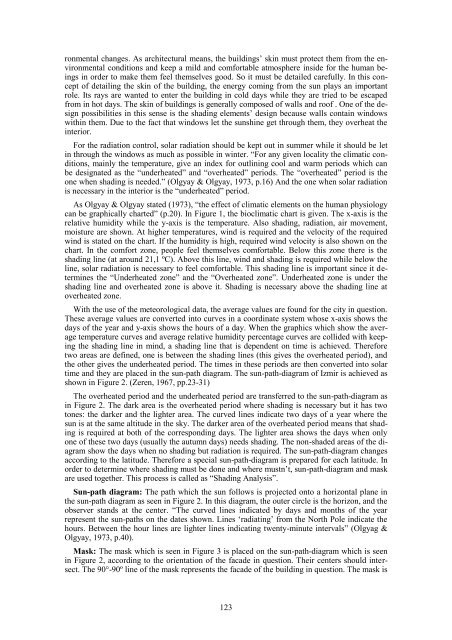
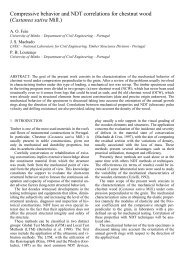
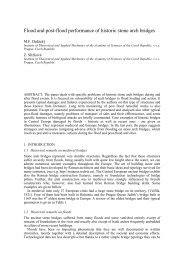
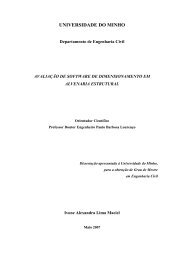
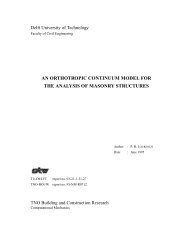

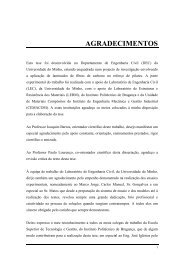

![Weibull [Compatibility Mode]](https://img.yumpu.com/48296360/1/190x134/weibull-compatibility-mode.jpg?quality=85)

